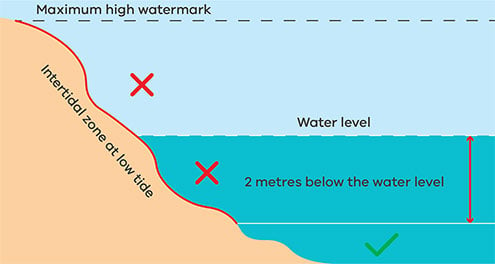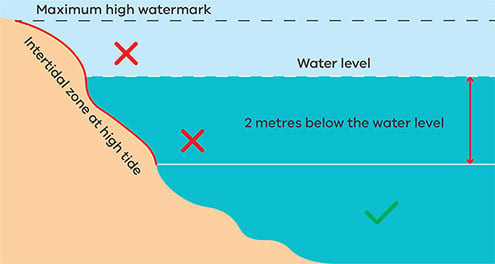Snorkelling the Intertidal Zone
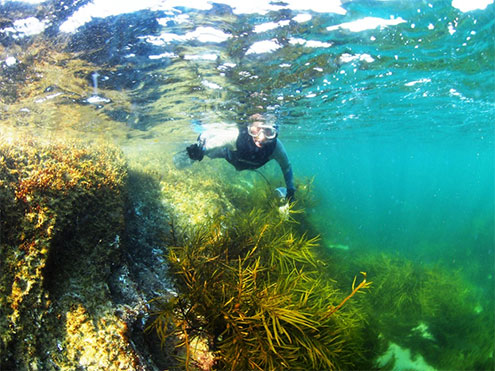
More than 95% of the animals and plants in Victoria's southern waters are not found elsewhere on our planet. This includes many of the seastars, molluscs, crustaceans, weedy seadragons and other creatures. Victoria's coastline is a part of the Great Southern Reef.
The shoreline area between the high and low tide is known as the "Intertidal Zone". This is an extremely challenging habitat for survival and is in a state of constant change. As the tide moves up and down, animals and plants must cope with problems like drying out, waves, and the presence of many predators. Only creatures that are well suited to these changes can survive here.
The intertidal zone is where most snorkelling occurs in Victoria. Thus it's important to be aware of the different intertidal zone types and restrictions.
Intertidal Zone Fishing Restrictions
All animals and plants that live in the intertidal zone are critical parts of the food chain. Removal of invertebrates (animals without backbones such as crabs, snails, shellfish and sea urchins) from this zone may seem harmless, but it represents a loss of food for other species. For this reason Victoria's intertidal zones are protected areas.
The intertidal zone is defined as the area starting at the maximum high-water mark to a point where the water is 2 metre deep at any time.
Rocky Shore Reefs
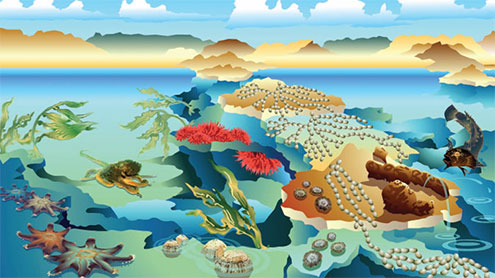
Rocky shore reefs are an especially important type of intertidal area. The rocks provide something solid for plants and animals to hold on to and also can provide some protection from changes in the environment and predators. As a result rocky shores are rich in plant and animal diversity.
Rocky shore reefs are found where rocks occur above or below the waterline. As the rocks are eroded by the action of water, cracks and holes appear which increase the availability of shelter for living things. Different rock types weather in different ways creating spectacular formations that can support different species.
Below the low tide mark rocky shore reefs can support extensive communities of marine plants which may include kelp forests. Reefs that are hidden from sunlight in deeper water, or under ledges, often have brightly coloured communities of invertebrates, many of which rival coral reefs for colour and diversity. Rocky reefs that are exposed at low tide are great places to explore as there are many animals and some seaweeds that can survive out of the water for some time.
Rocky shore reefs are also important because they provide habitat for many species of fish and other animals, including the Southern Rock Lobster (aka Crayfish) and Abalone.
Kelp Forests
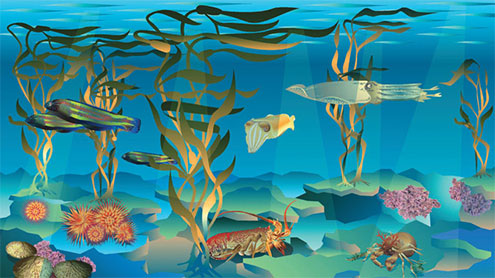
Kelp are a special group of large brown algae that attach themselves to solid structures to form forests. They extend their leaf-like fronds into the waters above them reaching towards the sunlight. These larger algae in turn create a habitat for smaller algae and a wealth of animals that can either live attached to the rocks beneath the kelp, on the kelp itself, or in the sheltered waters between the kelp.
Strong structures at the base of kelp (holdfasts) hold the kelp firmly to rocks, so that even when currents are at their strongest, kelp is in no danger of being swept away. On Victoria's coast kelp forests grow on most rocky reefs in waters to a depth of around 30 metres, although most are found in shallower waters.
In the same way that trees provide shelter and food for many different species, kelp are the true forests of the sea. Kelp forests have a dense canopy of blades, blocking out light which results in shading of the rock surface, providing an ideal environment for an understorey of encrusting algae and non-moving animals.
Bays and Estuaries
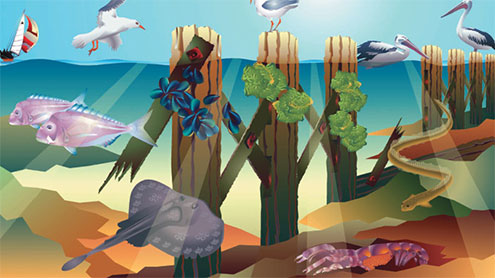
Sheltered from the large waves and winds of the open coast, bays and estuaries are important marine environments.
Estuaries occur where fresh and salt water is mixed, usually at the mouth of a river. In these environments there are a range of habitats with changes in salinity from freshwater to seawater. Hardy species that are able to tolerate the changing conditions live in these areas. Sand and mud built up at the mouth of rivers can lead to the formation of coastal lagoons.
Bays are much larger than estuaries and are often the remnants of ancient river valleys that have been flooded by rising sea levels.
Bays and estuaries are highly productive systems with a number of shallow water plant species as well as large numbers of microscopic plants in the sediment and water. Many smaller animals feed on detritus formed from dead seagrasses, algae, and other plant material.
Seagrass Meadows and Mudflats
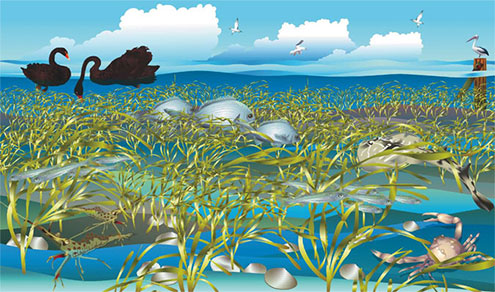
In the sheltered parts of many bays and estuaries, flowering plants called seagrasses can establish extensive underwater pastures that are some of our most important but challenged coastal habitats. Seagrasses are critical in the life cycles of many of our important fish species as well trapping sediments before they enter the sea.
While eaten directly by very few animals, the seagrasses provide shelter as well as contribute large amounts of plant material that breaks down to form detritus, a major food source for many invertebrates living in the seagrass habitat.
In places where low tides leave muddy sediments exposed to the air there may be few larger plants. These mudflats, however, teem with worms and other small animals which provide an important food source for wader birds, some of which come from as far away as the northern hemisphere.
Seagrasses in Victoria have suffered from a massive decline in the past three decades. Declines have been most serious in embayments with catchments that have been extensively modified for urban or agricultural development. As seagrasses may take many decades to recover once lost, seagrass decline is a major community concern. Loss of seagrass leads to reduced habitat for many commercially significant fish and internationally important bird species.
The seagrass areas at Flinders Pier and Portsea Pier provide the habitat liked by Weedy Seadragons. See also Weedy Seadragons Melbourne.
Saltmarshes and Mangroves
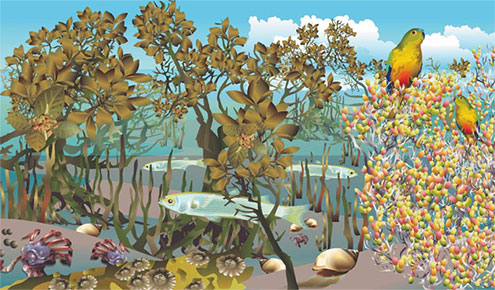
In coastal areas periodically flooded by seawater, communities of salt tolerant plants called saltmarshes can develop. The remaining saltmarshes are vitally important habitats for rare animals and plants.
Victoria also has mangroves. These small trees are capable of growing between the tides in thick mud. Mangroves are important as nursery habitat for many fish and crustacean species as well as trapping large amounts of silt and building up mudflats.
Both mangrove and saltmarsh habitats have been viewed as worthless in the past as they are generally areas that are muddy and smelly due to lack of air in the mud and the presence of mosquitoes. They are challenging habitats for conservation as people find them hard to enjoy. Victoria still has a number of sites where these now rare plant communities can be found, such as Western Port.
Sandy Beaches
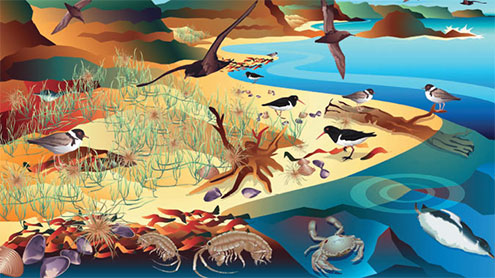
Sediment from eroding sea cliffs and materials brought down from the hills by rivers is deposited on the coast to form beaches. Longshore currents carry this material and deposit it behind rocky headlands. Sandbars that build up offshore provide a source of material for building beaches during calmer times of the year.
Far from being sandy deserts, beaches are home to a range of plants and animals, some of which are only found in these environments. Many small animals can live in the spaces between the sand grains in the water.

